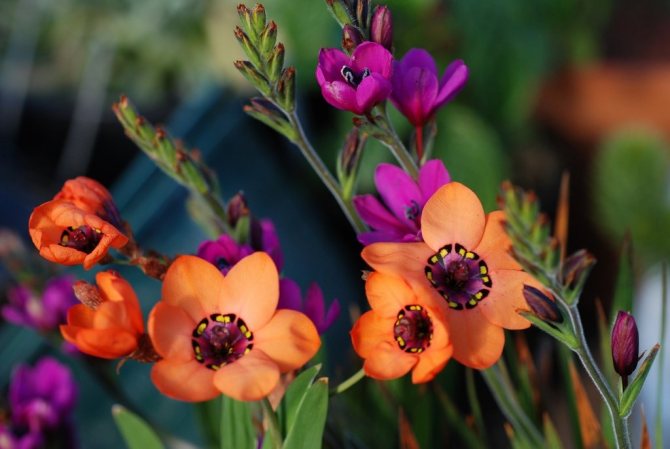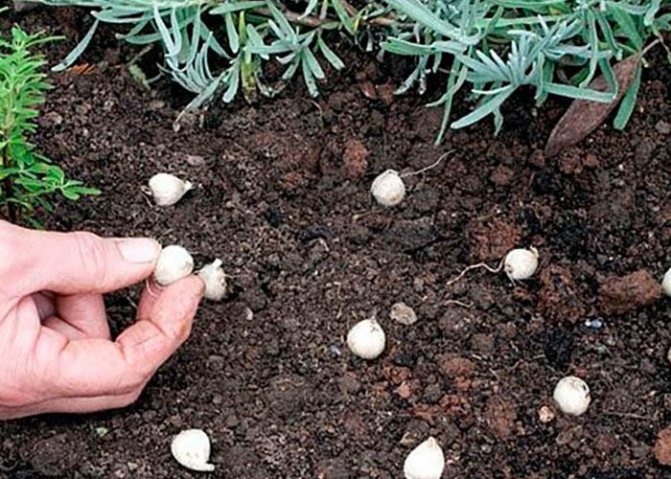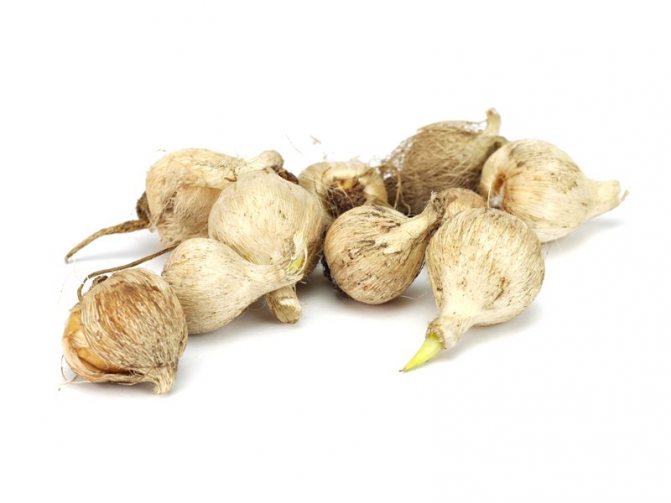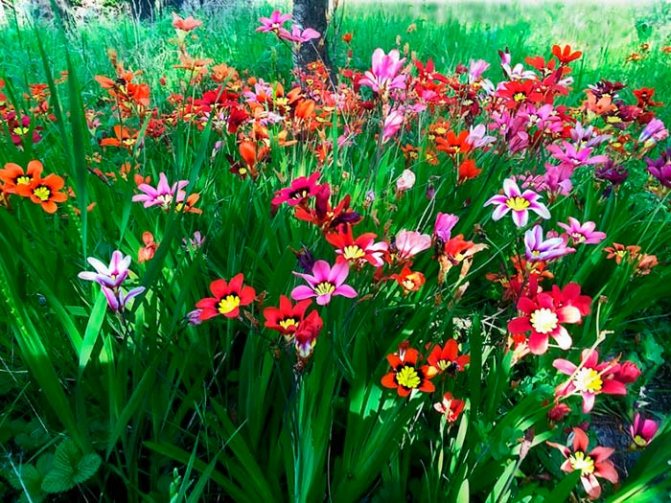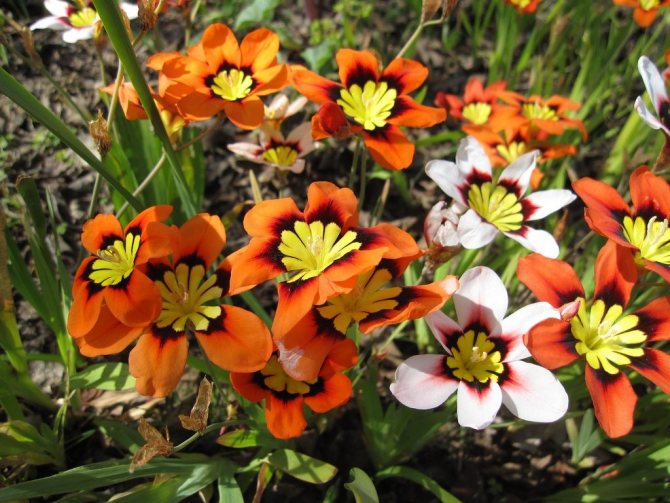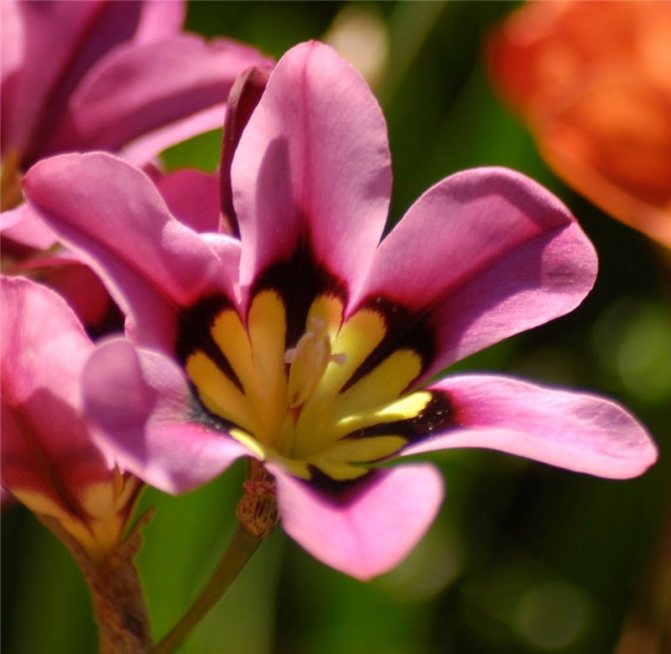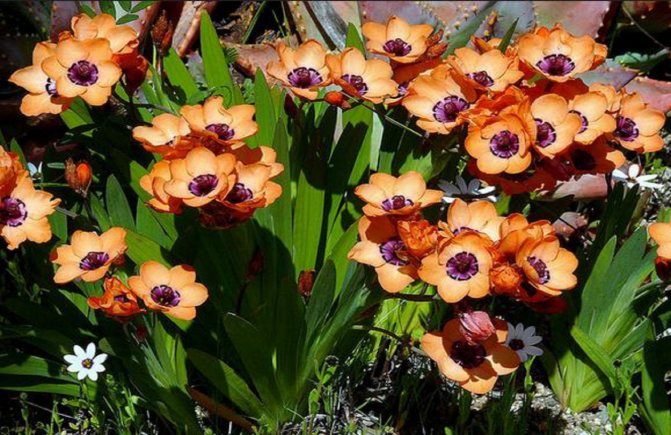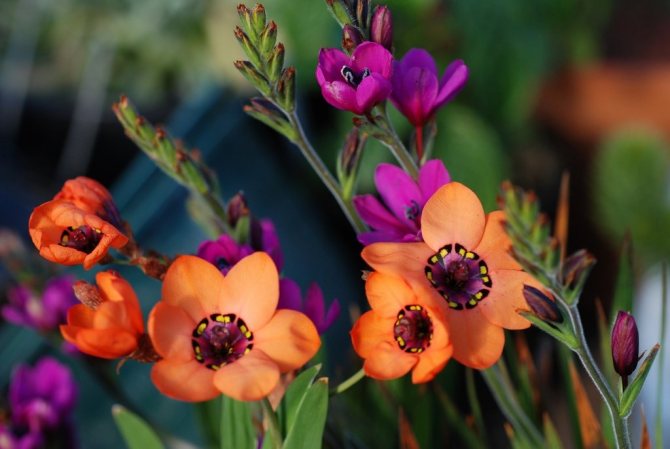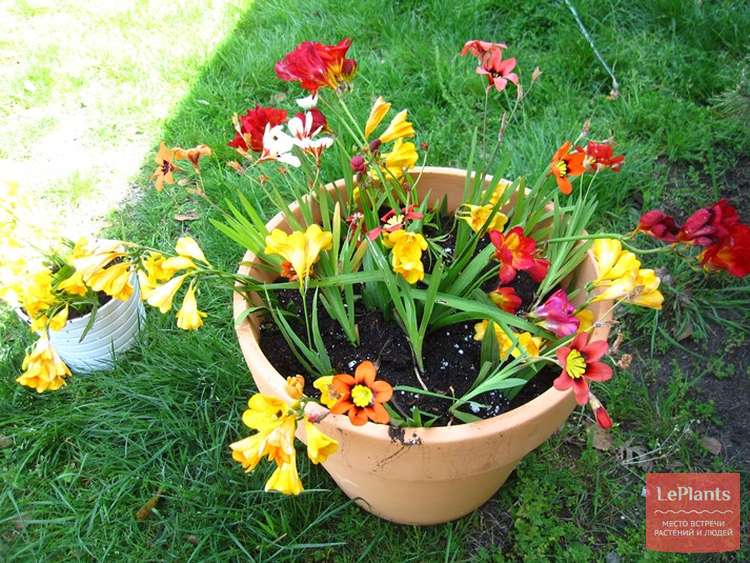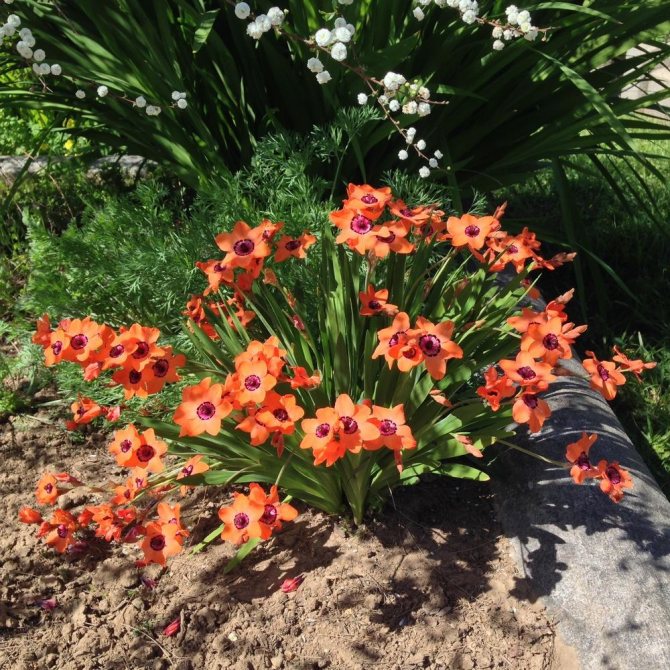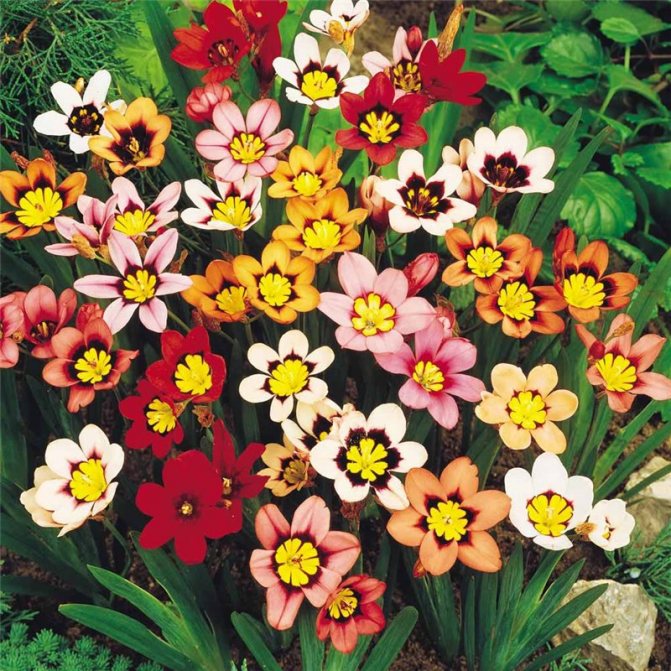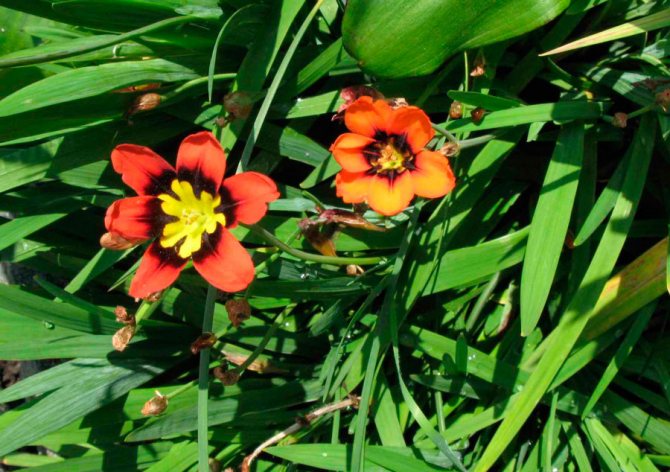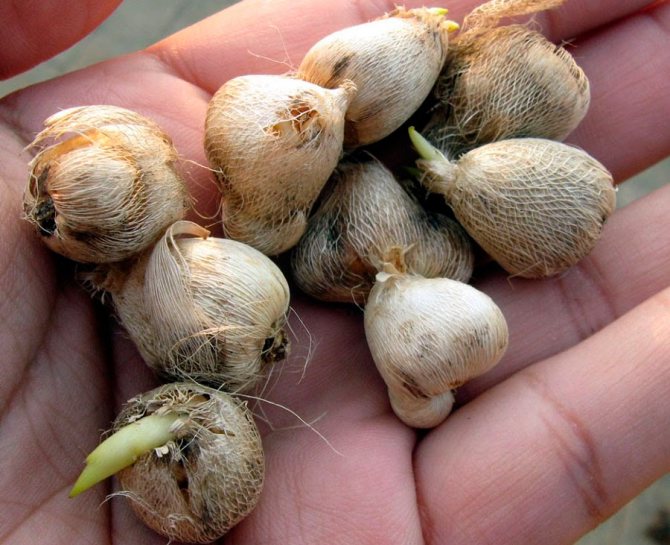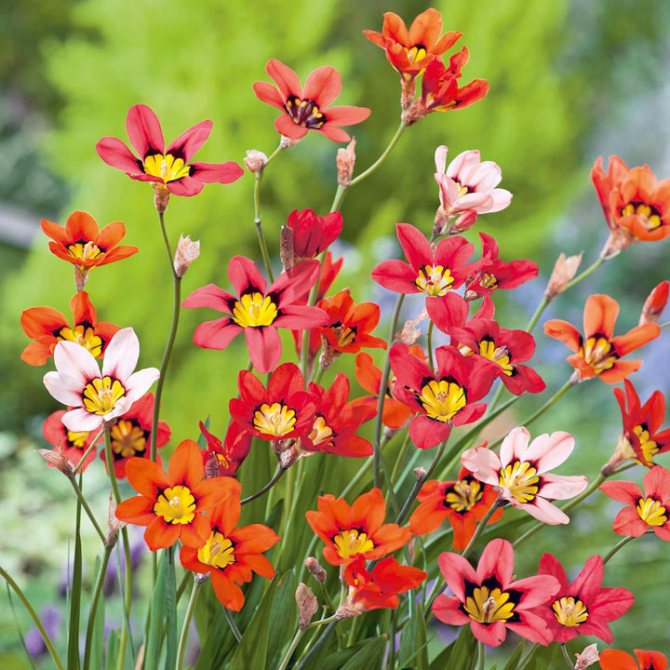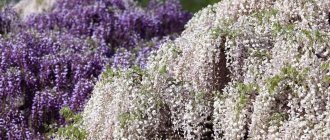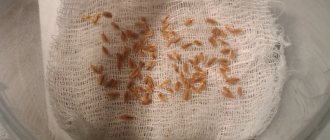Sparaxis, a corm herbaceous perennial plant, is a member of the Iris family. Under natural conditions, this plant is found in southern Africa, in the Cape region. And one of the species was introduced in California. There are 6 varieties of this plant, it is noteworthy that some scientists consider them to be different types, while other experts argue that these are variants of one species. Sparaxis has about 20 varieties. The name of the genus contains a Greek root, which translates as "splitting the ends of the bracts."
Planting sparaxis in open ground
What time to plant
The best place to grow sparaxis is in the southern region: spring is warm, summer is hot, autumn comes late, and winter is relatively warm and mild. When this flower crop is grown in mid-latitudes, in late autumn, its tubers are removed from the ground and stored, and with the onset of spring they are again planted in open soil. Planting tubers in mid-latitudes and colder areas is recommended from early to mid-May, after the soil has been very well warmed up. In the southern regions, where it is not colder than 1 degree in winter, tubers are planted before winter, in the last days of October.
Landing rules
An area suitable for planting should be well lit, open and protected from gusts of wind. If sparaxis is planted in a shaded place, then this will have an extremely negative effect on the growth and development of the plant. It will grow best on fertile loam, but it can be planted in other soil, as long as it is well drained.
The bulbs should be buried in the soil by 50–80 mm (depending on their size). The distance between the holes and between the rows should be about 8-10 centimeters. The planted tubers need abundant watering. The bushes planted in May will begin to bloom in August, and will finish with the onset of the first frost.
Gallery: sparaxis (25 photos)
Sparaxis care in the garden
Sparaxis grown in mid-latitudes should be cared for in the same way as the more popular flower crop, gladiolus. Such flowers need to be watered in a timely manner, weeded, and also loosened the soil surface between the bushes. During a drought, the aerial part of the bush should be moistened from a spray bottle in the early morning or in the evening, at sunset, because if the sun's rays hit the water droplets on the foliage, a burn may appear. It is also very important to remove flowers that have begun to fade from the bush in a timely manner, thanks to this, it is stimulated to form new buds and stems.
How to water and feed
At the beginning of growth, the bushes should be sufficiently watered. After each watering, the soil surface must be loosened, and, if necessary, all weeds should be pulled out. During prolonged droughts, watering should be carried out 2 or 3 times in 7 days, and be abundant at the same time. It should be watered exclusively with settled water, which should warm up well in the sun. Watering and spraying sparaxis is recommended in the early morning or in the evening at sunset.If water stagnates in the soil or watering is constantly excessively abundant, this can cause the development of fungal diseases.
During the formation of buds, the bushes need to be fed with a solution of complex mineral fertilizer for flowering plants (20 grams are taken for 1 bucket of water). During the season, the plant should be fed 3 or 4 times. When it fades, all feeding should be stopped. On hot days, it is recommended to moisten the aerial part of the plant from a sprayer using lukewarm, settled water. If this is not done, then thinning of the leaves will be observed, as well as shrinking of the buds (they may not form at all), this is due to the fact that the plant suffers from too low air humidity.
Reproduction of sparaxis
This culture can be propagated by seeds, as well as by children. The easiest way to reproduce is vegetative. When planting a plant in open soil, children should be separated from its tubers. Fracture points need to be sprinkled with coal powder, and then the children can be planted in pre-prepared holes. You should not separate the children in the autumn before laying the tubers for storage for the winter, the fact is that in 6 months they will most likely dry out very much.
It is also possible to grow such a flower from seeds, but this method is distinguished by its complexity and duration. A box is taken, the depth of which should be about 10 centimeters, and filled with a moist soil mixture saturated with nutrients. Seeds are sown into this container, after which it is rearranged to a very warm place with high humidity. After 20-30 days, the first seedlings should appear, after which they will need to be thinned, while a distance of 20 mm should be maintained between the plants. After the height of the seedlings is equal to 7-8 centimeters, it should be planted in the garden, while the soil should already warm up very well. Bushes grown from seeds will bloom for the first time only after 3 years.
Wintering
After the bushes have faded, further care will directly depend on how you grow this crop: as a perennial or annual. When grown in mid-latitudes and colder climates, after the sparaxis has faded and the part above the ground turns yellow, the corms should be removed from the soil. After the soil remains have been removed from them, they are transferred to a dry and well-ventilated room for drying, while the above-ground part does not need to be cut off. After the foliage dries very well, it will need to be carefully torn off, then the bulbs are stored in a cool (from 5 to 9 degrees) place. During the winter, it is recommended to carry out a systematic inspection of the planting material, in this case you will be able to timely identify rotten or dried tubers and remove them. When there is very little time left before planting in open soil, the planting material should be transferred to heat (from 25 to 27 degrees). Separation of children from the bulbs must be done immediately before planting. The planting material of this plant can be stored for 2 or 3 years.
When growing sparaxis in the southern regions, where it is not colder than 1 degree in winter, you do not need to dig it out for the winter. In this case, this crop is grown as a perennial. If you are still afraid that the bushes may freeze out, then for the winter they can be covered with spruce branches.
Diseases and pests
If sparaxis is provided with proper care, then it will not be affected by diseases or pests. However, if the liquid constantly stagnates in the soil, this will lead to the appearance of rot on the corms and, as a rule, in this case, the plant dies.
If the foliage of the bush has faded and faded, then most likely this is due to a lack of iron.To get rid of chlorosis, products containing iron in a chelated form should be added to the soil.
Sparaxis reacts extremely negatively to lack of sunlight, as well as cold.
Caring for the flower garden
During growth, drought is most dangerous for the plant. Lack of moisture leads to yellowing of foliage and few or even no buds. In dry spring watering is needed abundant and regular. To prevent burns, the plants should be sprayed with warm water early in the morning and in the setting sun.
As soon as the leaves appear, you need to start making mineral fertilizing: 15-20 grams of complex fertilizers are taken in a bucket of water. You need to feed the flowers once a month until the end of summer.

And the last thing you should do for your beauties is three weeks after the final completion of flowering (and this will be the end of July - mid-August), dig up the tubers for winter storage.
Types and varieties of sparaxis with photos and names
It has already been said above that in some cases it is extremely difficult to understand which sparaxis is in front of you, namely, species or variety. Below will be described those forms of this culture that are most popular with gardeners.
Sparaxis tricolor, or Ixia tricolor
The bush can reach a height of about 0.4 meters. The height of the peduncles also reaches 0.4 m, they bear from 5 to 7 pieces of graceful flowers, which can be two- or one-color. At the base of the petals, the flowers have a characteristic black ring that separates them from the rich yellow center. The shape of the leaf plates is xiphoid.
Sparaxis graceful (Sparaxis elegans)
The height of this dwarf plant does not exceed 0.15 m. The color of the flowers is white or orange. Among the gardener popular is "sparaxis mix", which is a variety mixture, which includes plants of various colors.
Sparaxis Bilbifer (Sparaxis bulbifera)
The height of a relatively large plant, which is distinguished by its unpretentiousness, is about 0.6 m.On the branched erect flower arrows, the formation of openwork inflorescences is observed, which include flowers reaching 60 mm in diameter, they can be colored yellow, light cream, white or a whitish yellow color.
Sparaxis grandiflora
This species is tall. The sheet plates have a belt-like shape. The flowers are large, elongated, they can be colored white, purple and deep yellow. The flowers have a very pleasant aroma, which is why this species is also called fragrant sparaxis. The most popular among gardeners are varieties such as:
- Superba... The height of the bush is about 0.25–0.3 m. The spike-shaped inflorescence contains from 5 to 7 flowers, reaching 50 mm in diameter, they can have orange, purple, white or yellow color, and their middle is black or yellow.
- Lord of fire... Scarlet flowers have a black center.
- Elegants... Fragrant flowers of dark purple color have a black center, and the stamens are white.
- sunny day... The lemon-cream flowers have a fuzzy edging located at the base of the petals. The yellowish middle also has fuzzy borders. In the lower part of the petals in the middle there are stripes of light crimson color.
- Moon color. Very beautiful white-lilac flowers are adorned with strokes of crimson, scarlet or dark purple color. The middle color is yellow, and the stamens are dark.
Features of sparaxis
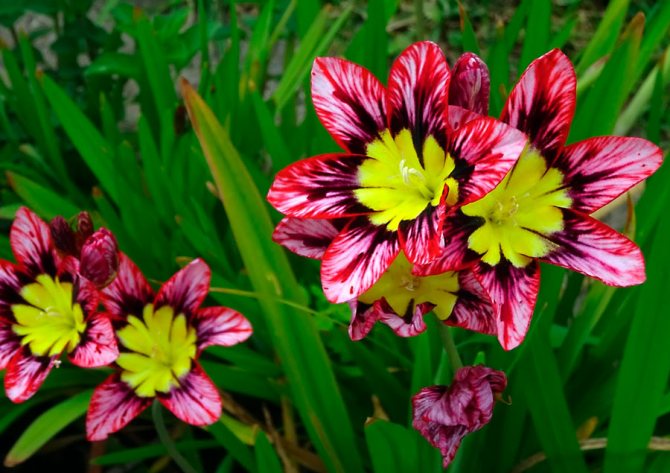

The height of sparaxis can vary from 0.15 to 0.6 m. Smooth bare leaf plates have a belt-like, lanceolate shape. The stellate flowers have a rich color and reach about 50 mm in diameter. The bracts are split at the tips, which is already clear from the name of the genus.The pistil column protrudes beyond a short perianth tube, which has a funnel-shaped shape. Weakly twisted stigmas are solid.
Description and features
What is the first thing that changes with the arrival of spring? Of course, it's getting warm, but it's not about the weather now. Everyone wants bright colors. After all, greens and bright buds have not pleased with their appearance for at least six months.
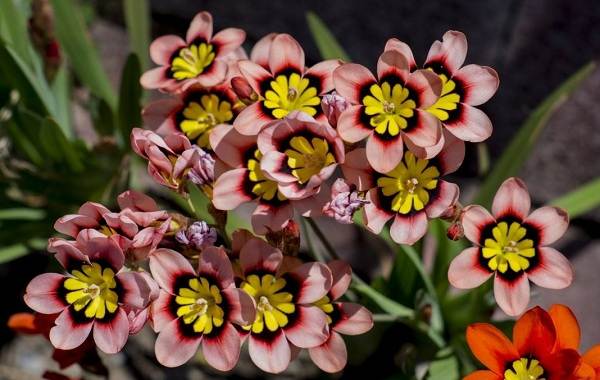

Gardeners undertake to revive the vegetable garden after hibernation. But in order for it to bloom, you will have to wait another month. However, there are some plants that can be called early risers. Among them sparaxis... This small flower will fill the garden with bright colors even before summer arrives.
The buds open in the spring months. True, not all climatic conditions are appropriate here. Initially, such a garden decoration could only be found on the African continent. Such "flower beds" went along the rivers. The stems can be called tall, because they reach one hundred centimeters in height. But, this is only in Africa, or where the climate is similar.
Now the plants have taken root in our country. Only now they gained the greatest popularity among the inhabitants of the south. It is understandable, in the north the flower either will not survive at all, or will make its owner sweat a lot in order to preserve the appearance of a “pet”. You will hardly be able to grow one meter tall plants, but half a meter high is quite.
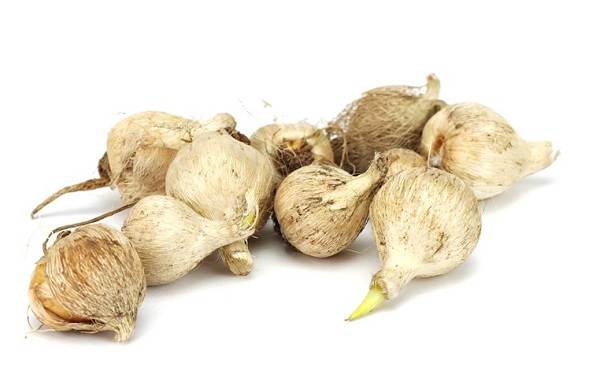

Traditionally, corms are very popular, because they can be called perennial. This is the bulb that will yield "harvest" from year to year. It is to this group that the flower sparaxis... It is also related to the iris family.
It looks like an inflorescence of small petals, each of which is two-colored. Moreover, these colors are contrasting, which only adds beauty. It can be all shades of sunny yellow, scarlet, purple, or white.
Together they form either a completely flat circle, or slightly raised and resemble a funnel. If measured, then the diameter reaches five centimeters. There is a pestle in the center of this whole composition. He is accompanied by three stamens.


The leaves are similar to sedges, they are oblong with pointed ends. Together with unusual pointed leaves, this creates an original composition. She will get along well with other "inhabitants" of your garden. To prevent these bright "stars" from getting lost in the ensemble, keep in mind that it is better to plant them in the foreground.
It is better not to be limited to one flower, but to collect in one place at once about a hundred stems. Then the desired effect of a bright and exotic garden will definitely be achieved. Such a garden dweller will look great in a hanging planter. The florists also loved this African representative. Cut pieces show themselves on the positive side in bouquets, they stand for a long time.
A spectacular plant is a winning place


This exotic looks very attractive in rock gardens - against the background of large stones and next to coniferous hills. Separate clumps of tricolor sparaxis look spectacular against the background of the lawn.
By planting it in the foreground of a flower garden, we get an accent that will attract the eye.
Sparaxis in combination with zshsholtsia, cosmea, coreopsis, tigridia. thyme becomes like a joyful and variegated Moorish lawn. And not so colorful Sparaxis Bilbeefer
and
grandiflora
add impressiveness to flower beds and invariably arouse keen interest - what kind of flowers are so unusual?
ORDER QUALITY AND CHEAP SEEDS AND OTHER PRODUCTS FOR HOME AND COTTAGE. PRICES ARE BOTTLE. CHECKED! JUST LOOK FOR YOURSELF AND BE AMAZED HOW WE HAVE REVIEWS. GO >>>
Below are other entries on the topic "Cottage and garden - do it yourself"
- Acidantera - planting and care: How to grow acidantera - I share ...
- How to cut shrubs correctly: Cutting and shaping shrubs - ...
- Planting strawberries: master class and photo: How to plant strawberries correctly - ...
- Tigridia - planting and care: Tigridia flower - growing and ...
- Do-it-yourself decorative flower bed: How to make a decorative ...
- A simple and easy way of harvesting seeds for the next year: Simple to the point of disgrace but effective ...
- Do-it-yourself vertical bed from a barrel: How to make a vertical bed from ...
Subscribe to updates in our groups and share.
Types and varieties
Not much is not enough - six different species of this plant are known to the scientific world. And there are even more varieties - as many as twenty. But, not all of them are able to withstand the weather conditions in our country. Therefore, now about those who successfully cope with this task:
- Tricolor, or sparaxis tricolor
This is a rather tall type of plant. The stems are capable of growing up to 40-50 centimeters. If we talk about color, then such buds are either snow-white, or red, yellowish, or different shades of purple.
The main distinguishing mark is that a third is added to the standard set of two colors. Those. the middle of the flower, for example, is yellow, it is ringed by a dark border, for example, brown, and after that there is the main color, it can be scarlet. This species includes varieties such as:
- The lord of fire. Everything is very clear from the name, because this bud looks like a flame. The core is surrounded by a pitch-black ring that turns into fiery red petals.
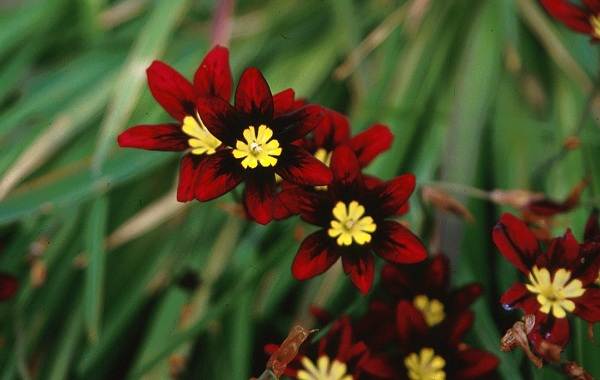

- Striped. If you look at such sparaxis in the photo, then you can understand that it is similar to the previous variety. But the main color here is red.


- Grandiflora. One of the longest stems is its hallmark. You can also distinguish the variety by its pronounced aroma.


- Low-growing mix. These, on the contrary, are very short, only fifteen centimeters high - their limit. The color scheme can be completely different.


- Elegant. Fiery color and even more modest size (maybe only ten centimeters in length) makes it stand out from other varieties.
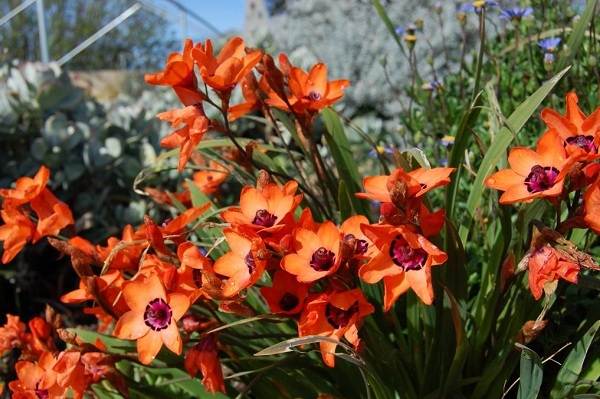

- Bilbeefer. Their palette is dominated by white. The petals are arranged in a funnel and sit on a fairly high stem. It is considered by many to be the tallest variety. But whatever soil does not suit him, he prefers sandy flooring.


- Another popular type is sparaxis superba.
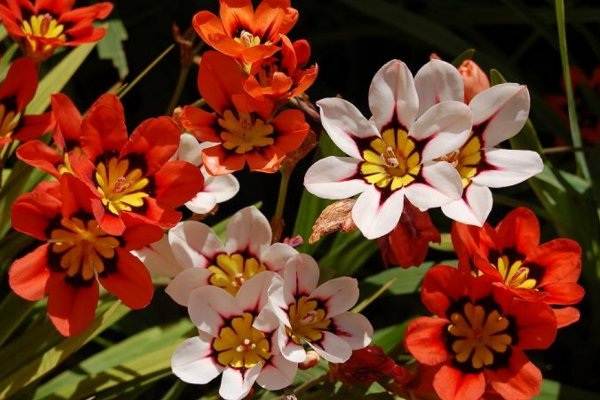

Don't expect tall bushes. No, a maximum of three tens of centimeters in height. The stars themselves are small, the size is standard. Five pieces may well make up one inflorescence. The circle in the middle of the composition can be sunny or black. It is complemented by shades of lilac, orange and snow-white.
Where to buy planting material?
Sparaxis is a fairly common plant in our country. That is why the purchase of planting material can be carried out in a variety of places:
| Place of purchase | The cost |
| Market | 50 rubles |
| Flower shop | 75-90 rubles |
It is best to purchase the plant from a flower shop, despite the inflated cost. Here they will provide a complete description plants, and also tell you how to grow it from the bulbs. In addition, only high-quality planting material is sold in specialized stores, which will guarantee abundant flowering.
When and how to plant
Those who have already dealt with gladioli will find a lot in common with these representatives of the flora. Given what features the hero of this article has, planting sparaxis the easiest way is with bulbs. You can buy them or get them yourself.
To do this, when the time of autumn comes and the flowering comes to an end, the bulb is dug up. She had already been divided into several fragments by that time. They are very carefully separated from each other. Here are the preparations for the future garden.
Initially, you need to let them dry. It will take five days. So that they retain their vitality, where they can not be left anywhere.Since these "embryos" have to wait in the wings until spring, it is necessary to create suitable conditions for them.
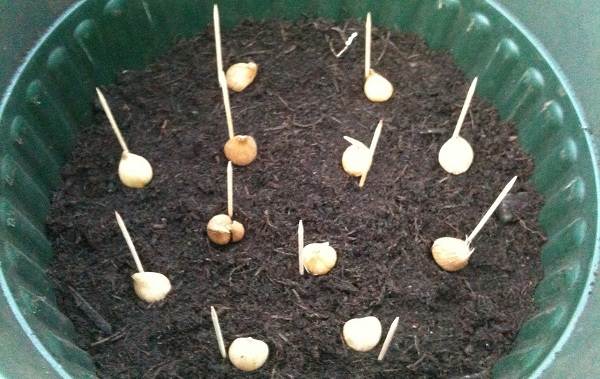

First, the temperature. It should not be hot - maximum +10. But it's not cold either, so look for suitable places in the house, it could be a cellar. The second thing is to take care of the constant supply of fresh air into the room, ventilate.
And finally, you just can't put them on the floor, you need some kind of substrate. Sawdust is quite suitable for these purposes. If you did everything correctly, you can not worry, the planting material will retain its capabilities for as long as three years.
When spring is on the doorstep sparaxis bulbs must survive the move. To begin with, bring them where it is warmer, and significantly. The average room temperature in the living area is fine. In a new place, the tubers should spend a couple of weeks.
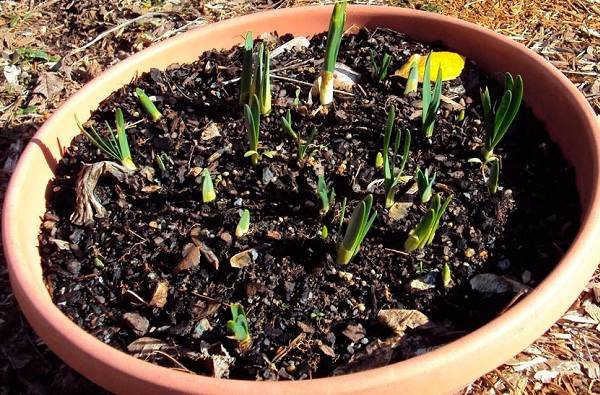

After that, you need to decide where you will plant - in a pot, or immediately outside. But in any case, you need the right mixture for this. The set of components will be as follows: loam plus sand (the ratio should be 50/50), plus some kind of organic fertilizer.
Compost can serve as the latter, humus will also do. In addition, a prerequisite is a drainage layer. Make sure it is at least five centimeters thick.
Both expanded clay and ordinary gravel will do here. The hole should be small, only ten centimeters deep, but the distance between the planted tubers should be doubled.
If we talk about when to plant sparaxis, then here you still need to remember that this flower is thermophilic, therefore, if you do not live in the warmest latitudes of our country, do it in March.
Then at the height of summer you will be delighted with bright inflorescences. If the climate in your region is mild, you can plant it in the fall. Then in May you can count on flower beds pleasing to the eye. And by the middle of summer, such buds will fade. The main thing to remember here is that if the temperature drops below zero, the case is gone, the tubers will die.


When there is a desire, you can resort to another way to acquire such beauty in your garden - to buy seeds. But, get ready, everything will not be so simple here. If at least you allow the temperature to drop, you can say goodbye to this idea.
First, take a box, or a special planter. The container must be filled with suitable soil. The seeds do not need to be deepened too much, a centimeter will be enough, you can lower them into the ground and to a shallower depth.
Then you need to wrap all this economy with a film and leave it alone for a while, but only where it is warm. Do not forget about moisture, it must be supplied in sufficient quantity. Have you noticed the first shoots? - take care of thinning right away.
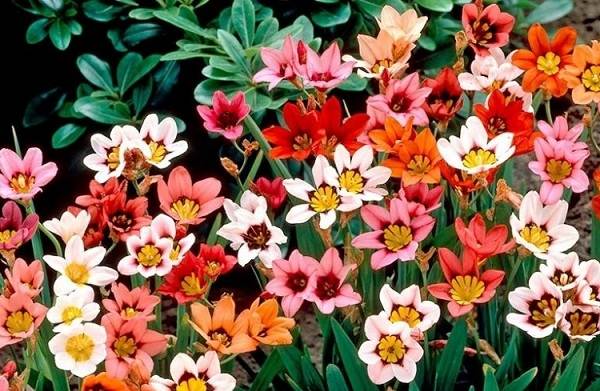

Maintain a two centimeter distance between plants. The next step is to wait until the seedlings reach a height of eight centimeters. Watering and sunlight should be provided during this time. When the plants have reached the desired size, you can move them to a place of permanent residence. But remember that after transplanting, there is no frost.
These flowers look best in a group. Therefore, do not scatter plants alone throughout the garden. Arrange a whole "island" of multi-colored inflorescences. If we are talking about very long varieties, then take a stock of 10 centimeters when planting, you should not plant them closer.
If you like not so tall plants, then four centimeters will be enough. But there should be no trees nearby that will create a shadow, because your flowers need more warmth and light.
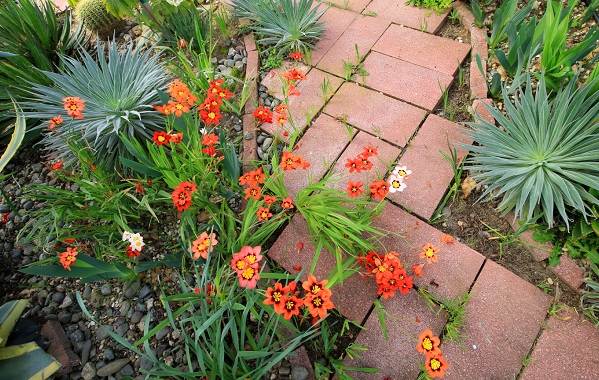

Outlandish garden decoration
In order for sparaxis to fully reveal its decorative properties, it is necessary to plant it in large dense arrays. Single flowers can get lost in the garden, but dense multi-colored plantings allow you to create an interesting composition exclusively from sparaxis.
It is important to remember that by the end of summer it will completely wither and you will need to fill the void with other plants. It perceives well the proximity of thyme, phlox, tigridia, stonecrop. Combines well with lawn grass and ground cover green plants. In this case, the effect of a natural lawn is created.
The compact varieties are suitable for planting in pots to decorate a terrace or balcony. Also, bright flowers are planted in rock gardens or decorate with evergreen shrubs and dwarf trees.
Growing and care
If you live in southern latitudes, then sparaxis care shouldn't be too much trouble for you. When frosts come, the bulbs can be safely left in their place and not waste energy digging them up. True, you will have to extract the root from the earth once.
If you planted a tuber in the fall, and by the middle of summer the plant has already faded, then it needs a rest. To do this, you need to remove the bulb from the ground in the last summer month and let it dry. And when it gets colder again, return the seed to its place.
As we have already said, in winter you will not have to repeat the procedure, just provide shelter for the place where such a “seed” “sits”. Mulch is suitable for these purposes. But do not forget to remove such a cover at the beginning of spring. Such a "pet" will feel good in greenhouse conditions, because greenhouses are what you need.


If you are not so lucky with the climates, and you live in not the warmest corners of our country, then there is no way without winter digging. It adds to the hassle that these bulbs are still finicky. They can rot easily. Few can boast. That he managed to save all 100 percent of such "winterers". As a rule, some of the planting material simply dries up.
For a flower sparaxis cultivation can be carried out in a combined form. Those. On warm days, the plant can calmly spend outdoors, and in frosts, it can move into the house. To carry out such a scheme allows planting in flowerpots.
To do this, at the end of the first autumn month, place the bulbs in the soil with which large pots are filled, or special. garden containers. They should sit about three to four centimeters deep from the surface of the earth.
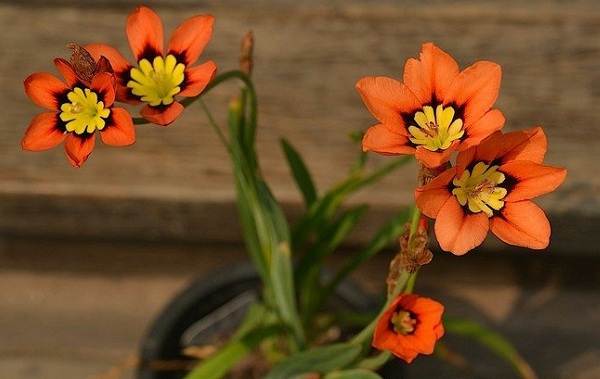

Before the onset of frost, all this is placed in hotbeds, greenhouses. When the frosts get stronger, the pots should be brought into a warm room. And only in the spring months they are again taken out into the fresh air. The flowering period lasts a couple of months, then the root should be dug out.
It goes into storage until September. And then you can again plant the plant in the same pot, but do not forget to refresh the soil. Why are all these manipulations necessary? Because so, the percentage of tubers preserved for the winter is increasing significantly.
Please note that regardless of whether the outdoor sparaxis, or indoors, there are several golden rules for courting him:
- No blowing. Ensure that there is no draft
- Balanced ground. Those. you need to strictly follow the instructions and observe the proportions when disembarking
- The sun is the best friend of these plants. Even a small shadow can be fatal to them.
- Water! There should be enough of it, and it should be done on time. The earth must be constantly moist. If the summer heat has heated the air, you will have to water it more than once, and not even twice a day. Plus, spraying can be done in the morning. For all these purposes, you should not take water directly from the tap. Only settled, and slightly warmed up (to room temperature) will do.
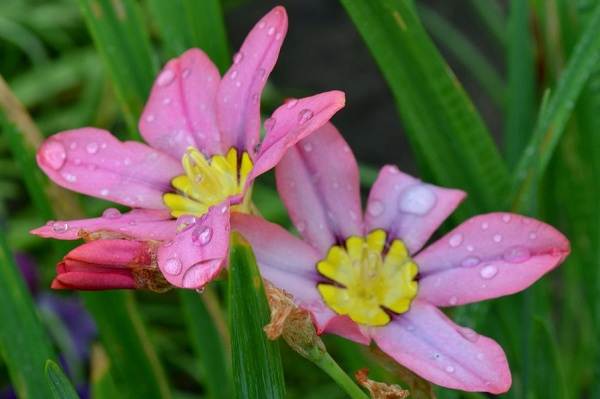

And now about the feeding schedule. This procedure must be performed strictly once every one month. The final one should be at the end of the flowering stage. And one more obligatory procedure - be sure to tear off the leaves and wilted petals and throw them away. Otherwise, your flower bed will look like a herbarium.
Care features
Sparaxis is a gentle heat-loving plant that does not tolerate frost.Therefore, in temperate climates, the bulbs are dug up in the fall and stored dry on sawdust or peat until spring. In the warm season, they are again planted in the ground.
The plant is very fond of regular watering, but without stagnant water, otherwise the roots can simply rot. In intense heat, ground shoots should be sprayed with warm water, but this should be done early in the morning or in the light of the setting sun so that water droplets do not provoke a burn.
A cool and rainy spring is needed to produce more flowers. You can create the right conditions with regular watering.
Withering inflorescences and foliage are removed, then new shoots are formed in their place. Every month the plants are fertilized with mineral dressings in the amount of up to 20 g per bucket of water.
In August or September, when the flowers have withered, the plant begins a dormant period. It sheds foliage and disappears completely from the surface of the earth. It is important not to forget that there are tubers left in the ground and not to damage them when weeding or digging.
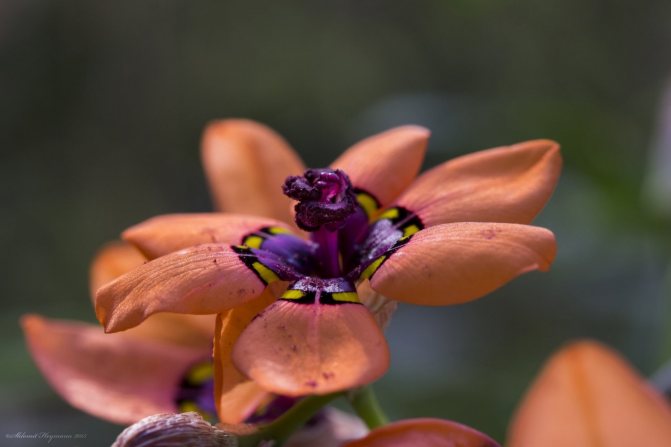

Growing sparaxis as a houseplant is difficult. He needs to provide good lighting and high humidity, while the air in apartments in winter is often dry. The conditions of a winter garden or greenhouse are ideal, where the plant will delight the owners with abundant flowering for several years.
Diseases and pests
Although the flower loves moisture, constant overdose of liquid can cause plants to rot. Another ailment that can affect greens is chlorosis. Its signs are yellowing of leaves and cessation of growth.
Iron deficiency can lead to these symptoms. To fight the disease, arm yourself with chelated products. With their help, it is necessary to process the plant subject to the disease.
Gardeners are also not immune from such misfortune as pests. For example, a spider mite. Here insecticides will come to the rescue. You can understand whether these insects have settled on a flower by the characteristic spots, they are either light green or beige. If the pest has chosen the place for a long time, then the cobweb is attached to all of the above.


Burrowing insects such as bears can damage the bulbs. They just gnaw at the roots. To avoid this situation, arrange traps for malicious bugs. These should be small holes next to the flower beds.
Place manure in these holes. True, a cow will not be as good for these purposes as a horse. Then all the insects will run there like bees to honey. And when they all accumulate in one place, it will be much easier to destroy them. If suddenly this bright representative of the garden "refused" to bloom, the reason may be a cool or too cloudy summer.
Most often, the bulbs of this plant are sold in a set, which is called assorted, and on such packages you can see the inscription “sparaxis mix". This means that in one pack you will find several different varieties of the same species at once, all of them can be of different colors.
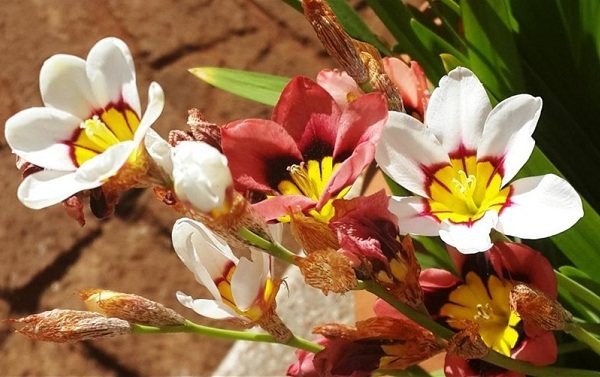

One tuber will empty your wallet in the amount of 10 to 20 rubles. If you decide to take up the cultivation of these representatives of the flora from seeds, you can save a little. You will have to pay about twenty to thirty rubles for the package.
But an exhibit already grown by someone else's hands is a more expensive pleasure. Much depends on the variety. Based on which one you have chosen, one inflorescence is estimated at an amount from 200 to 400 tons. Plus you will have to spend money on a suitable pot.
Sparaxis (lat.sparaxis) - a genus of herbaceous bulbous perennials of the Iris family, growing naturally in southern Africa, in the Cape region. One of the species - tricolor sparaxis - was introduced in California. There are 6 varieties of sparaxis, which are considered by some specialists as variants of one type, and by others as several different types.As for the plant varieties, there are about 20. The name of the genus has a Greek root and in this case means "splitting the ends of the bracts."
Reproduction of sparaxis
The bulbous plant can be propagated at home by seeds and corms. True, the option with seeds is allowed only in warm climates or when planting in a greenhouse, since it is necessary to preserve seedlings without digging up for 2 years before flowering.
Seeds are sown in regular pots or seedling beds in August. They need to be germinated warm in a nutritious loose substrate. After the emergence of seedlings, thinning is carried out. After strengthening the young shoots, they are transferred to greenhouses or open ground.
Planting and caring for sparaxis (in brief)
- Bloom: in May-June, sometimes in August - depending on the timing of planting tubers in the ground.
- Landing: planting tubers in the ground in regions with a warm climate - at the end of October, in areas with cold winters - in early or mid-May.
- Lighting: bright sunlight.
- The soil: rich loam is best, but poorer soils are also suitable.
- Watering: at the beginning of growth and in drought - frequent (2-3 times a week) and abundant, however, the soil must be allowed to dry out between waterings. In extreme heat, it is advisable to spray flowers in the evenings with warm water.
- Top dressing: during the budding period - with a solution of 20 g of complex mineral fertilizer for flowering plants in 10 liters of water. In total, 3-4 dressings are carried out per season, but after the completion of flowering, fertilizers are no longer applied.
- Reproduction: seeds and children.
- Pests: bears and bears.
- Diseases: rot and chlorosis.
Conditions for growing Sparaxis
Sparaxis is the closest relative of tulips, gladioli, daffodils, irises and other corms in the garden, which have long been mastered by gardeners in the temperate and subtropical climate of northern latitudes.
Briefly, agrotechnical conditions for growing can be formulated as follows:
- illumination - landing in well-lit areas protected from the wind;
- soil - drained, fertile, loamy;
- humidity requirements - moderate watering, during drought - 2-3 times a week; sprinkling in hot weather;
- landing: depth - 6-9 cm, distance - 10-15 cm; soil temperature during disembarkation - not lower than 180 ° С;
- flowering period - May-August, depending on the timing of forcing corms, weather conditions.
The creation of the listed conditions is possible taking into account the weather conditions and the composition of the soil in a particular area.
Place on the site
Sparaxis gets along well with any plants in the garden. But, as a rule, it is planted with herbaceous and shrubs that require similar agrotechnical conditions. When choosing a place to grow sparaxis, preference should be given to elevated areas where water does not stagnate after rain, constantly illuminated by the sun and protected from the cold wind.
The soil
In southern Africa, from where sparaxis came to northern subtropical and temperate latitudes, flowers grow on gray-brown soils of subtropical steppes, characterized by a high content of calcium, humus, and neutral acidity. To increase fertility, such a soil composition requires irrigation and the introduction of a mineral complex: nitrogen, phosphorus and potassium.
Corms develop better, gain weight with good soil aeration. In addition, the short and thin roots supplying the sparaxis bulbs are prone to decay at a high density of waterlogged soil. Adding sand to the area where the bulbous plants are to be planted will provide drainage and keep the roots from rotting.
It is allowed to use sandy loam soil for planting, but it is recommended to carry out autumn digging with the addition of organic matter. You should not fertilize the area with humus before planting the bulbs in the spring, as this can lead to their decay.The exception is wood ash, rich in potassium, which can be applied throughout the growing season, and mineral supplements.
Planting sparaxis in open ground
When to plant sparaxis in the ground
Planting and caring for sparaxis is not difficult. The flower grows best in the southern regions with warm springs, hot summers, late autumn and cold winters. If you live in the middle lane, you will have to dig up the tubers of the plant for the winter, and in the spring, plant them again in the ground.
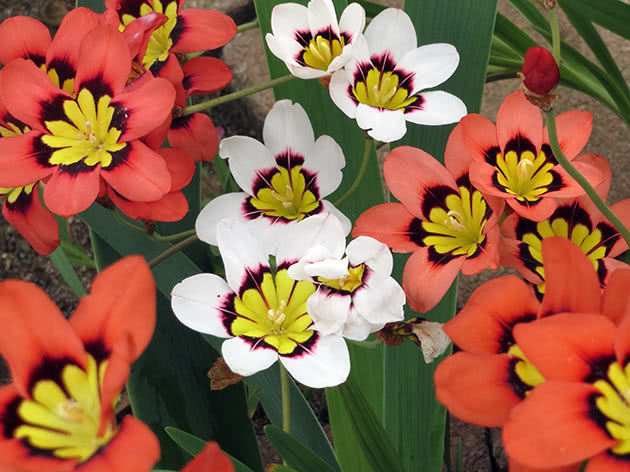

Sparaxis tubers are planted in regions with cold winters in early or mid-May, when the soil warms up, and in southern areas, where the air temperature does not drop below 1 ºC, planting is carried out before winter, at the end of October.
How to plant sparaxis
The site for sparaxis is organized in open, sunny, but protected from the wind places. In the shade, sparaxis develops and blooms poorly. The optimal soil for this plant is rich loam, but other soil will work as well if it is well drained.
Sparaxis bulbs, depending on their size, are planted to a depth of 5-8 cm, and the distance between them is kept 8-10 cm with row spacings of the same width. After planting, the site is watered. If you plant sparaxis in May, you will only see flowering by August, but it will last until the frost.
What does sparaxis love?


It is not difficult to grow a sparaxis flower from a purchased corm, but in order for this plant to show itself in all its glory, you will need special soil preparation, and a good place, and most importantly - an understanding of the "character" of this exotic. Sparaxis loves open, sunny areas, without shading, well heated, protected from wind and drafts. He prefers rich, fertile loam, with a loose structure, well-drained.
Corms of all sparaxis are sensitive to stagnant water, especially in summer. In waterlogged or insufficiently drained soil, they easily rot, and this leads to the death of the plant. Therefore, when preparing the site, it is imperative to lay good drainage; it is also recommended to add expanded clay, medium-sized gravel to the soil. By the way, in the natural area of this plant, the soil is rocky.
The peculiarity of sparaxis is that, with a high sensitivity to excessive moisture, it still loves moisture, and not only the moisture of the soil, but also the air is important. This is due to the fact that in his homeland he wakes up at the end of a rainy wet winter (winter temperature in the Cape region is 0-12 ° C), manages to grow and bloom before the onset of summer drought, which he waits at rest.
So in our conditions, the largest number of flowers sparaxis forms if the spring is cool and moderately rainy. At the beginning of the growing season, he needs coolness. Because of this, they try to plant the corms early, usually in April, before the onset of the spring heat. Sparaxis blooms 2-3 months after planting. The necessary microclimate for it is created by careful watering, spraying of plants and the air around them.
Sparaxis care in the garden
How to care for sparaxis
Growing sparaxis and caring for it in an area with a cold climate is carried out according to the same rules as growing gladioli. The plant will need regular watering, loosening the soil and weeding, spraying its ground organs during a drought period at dawn or after sunset, so that drops of water falling on the leaves and flowers do not cause a burn. It is recommended to remove wilted flowers and leaves from the bushes, stimulating the plants to form new buds and shoots.
Watering and feeding sparaxis
Sparaxis is watered at the very beginning of growth quite often, each time after moistening the soil, loosening the soil on the site and removing weeds. In dry times, the plants are moistened abundantly, 2-3 times a week. Water for irrigation is used settled, heated in the sun. Better time for moistening the soil, as well as for spraying the plant - early morning and evening after sunset.Chronic waterlogging of sparaxis leads to stagnation of water in the roots and can provoke fungal diseases.


During the budding period, sparaxis is fed with a solution of 20 g of complex mineral fertilizer for flowering plants in 10 liters of water. In total, 3-4 dressings are carried out per season, and with the end of flowering, fertilization is stopped. And do not forget to spray sparaxis with settled warm water in the heat: if the foliage on the plant has thinned, the buds are small or not formed at all, this means that sparaxis suffers from dry air.
Reproduction of sparaxis
Sparaxis multiplies both by seed and vegetative, namely by the separation of children.
The vegetative method of reproduction is simple and easy to perform: before planting in the ground, the children are separated from the mother bulb and, having processed the break points with crushed coal, the daughter bulbs are planted in the prepared holes. You should not separate the children before winter storage, since they can dry out in six months.
Growing sparaxis from seeds is less popular as it is labor intensive and much more time consuming. Sow sparaxis seeds in a box about 10 cm deep filled with moist nutrient medium. Crops are placed in a warm place with high air humidity. The seedlings that appear after 3-4 weeks are thinned out so that the distance between them is at least 2 cm. When the seedlings reach a height of 7-8 cm, they are planted in well-heated soil. Sparaxis from seeds will bloom only after three years.
Sparaxis in winter
Caring for sparaxis after flowering depends on whether you are growing it in an annual or perennial crop. In the middle lane and cooler regions, the corms of the plant, after the leaves turn yellow, are dug up, cleaned from the ground and dried together with the ground part in a dry, well-ventilated room. When the leaves are completely withered, they are separated, and the corms are stored at a temperature of 5-9 ºC. In winter, you need to periodically inspect the planting material in order to remove dried or rotting specimens in time. Closer to the time of planting in the ground, the storage conditions of the corms change: the temperature is increased to 25-27 ºC. Before planting, babies are separated from the mother's bulbs. So sparaxis corms can be stored for 2-3 years.
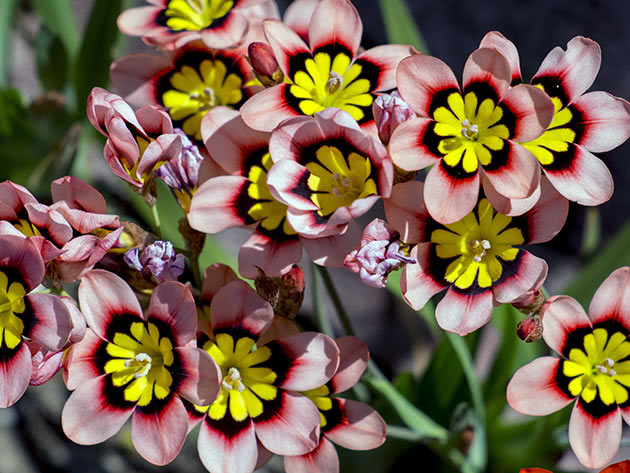

If you live in the south, where there is no subzero temperature in winter, it is advisable to grow sparaxis in a perennial crop, without digging its tubers out of the ground for the winter. Just in case, you can throw spruce paws on the flower garden and forget about sparaxis until spring.
Gentle wintering
If you are fond of the sparaxis flower, planting and grooming should include helping you survive in the cold. Since this plant is tropical, the tubers left in the soil will freeze out by spring. Therefore, the bulbs are carefully dug up and placed in wooden boxes filled with sawdust, peat or moss. For storage, a room is allocated with a temperature not higher than +10 degrees, but not lower than +5. In the south, where winters are mild, tubers can be left to winter in the ground, just cover them well with fallen leaves.
Sparaxis pests and diseases
With proper care, sparaxis is resistant to both pests and diseases, but if you allow chronic waterlogging of the soil, rot can affect the corms of sparaxis, and this usually leads to its death.
If the leaves of the plant become dull and light, it is possible that the sparaxis lacks iron. Chlorosis can be eliminated by introducing preparations containing this element in a chelated form into the soil.
The main enemies of sparaxis are cold and lack of sunlight.
Growing from seeds
Since the plant is demanding, its cultivation must be approached responsibly. Here, preliminary cultivation of seedlings in boxes with fertile soil is required. Sparaxis prefers to grow in a humid and warm climate, and therefore crops are kept in greenhouses or conditions close to them.
Seeds are placed in the ground to a depth of 10 mm and covered with foil until shoots appear. The young growth is thinned out, leaving a distance of 2 cm between the plants. The seedlings are watered regularly and kept in a well-lit place. When the plant reaches 6 - 8 cm, the seedlings are transplanted into open ground. At the same time, it is important that the threat of frost has already passed.
Planting sparaxis in a permanent place involves maintaining a distance of 15 cm (growing under the cut) or 45 cm (for decorating the garden). The first year after sowing, flowering should not be expected, since the plant takes root and gains mass after planting.
Types and varieties of sparaxis
As we already wrote, it is sometimes difficult to determine what we are dealing with - a species or a variety of plants. We present to you the most famous forms of the genus Sparaxis, grown in garden culture:
Sparaxis tricolor (Sparaxis tricolor)
or sparaxis tricolor (Ixia tricolor) - a plant up to 40 cm in height with the same height of peduncles, on which 5-7 graceful flowers of one-color or two-color color open with a characteristic black ring at the base of the petals, separating them from the bright yellow center. The leaves of this species are xiphoid.
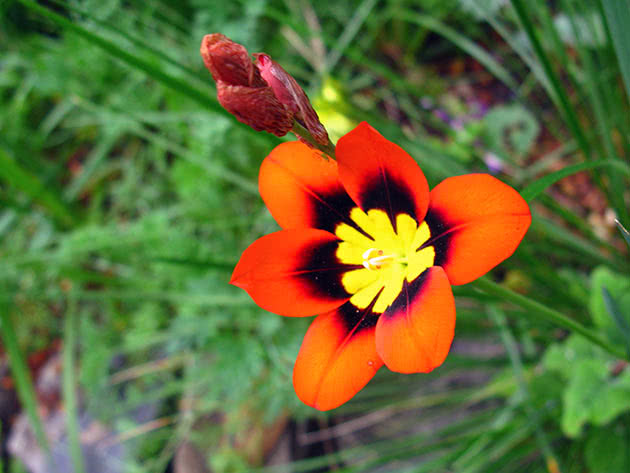

Sparaxis graceful (Sparaxis elegans)
- dwarf plant up to 15 cm high with orange or white flowers. Popular is "sparaxis mix" - a variety mixture of plants of this species of different colors.


Sparaxis Bilbifer (Sparaxis bulbifera)
- a large unpretentious plant up to 60 cm high with erect, branched flower arrows, on which openwork inflorescences of white, yellow, yellow-white or pale cream flowers with a diameter of up to 6 cm are formed.
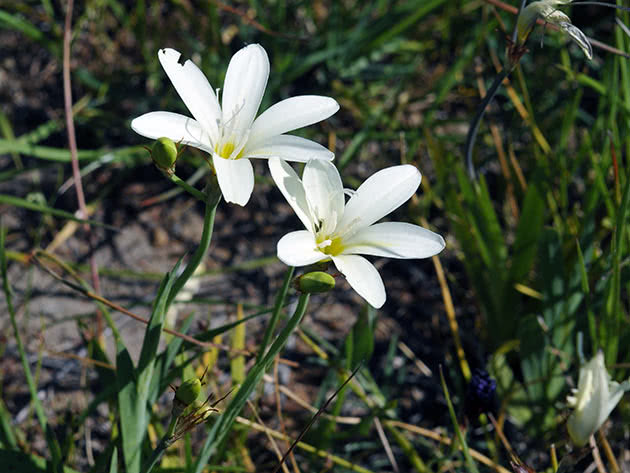

Sparaxis grandiflora
- tall species with belt-like leaves and large elongated flowers of purple, white or bright yellow color. For the amazing aroma of flowers, this species is called fragrant sparaxis.
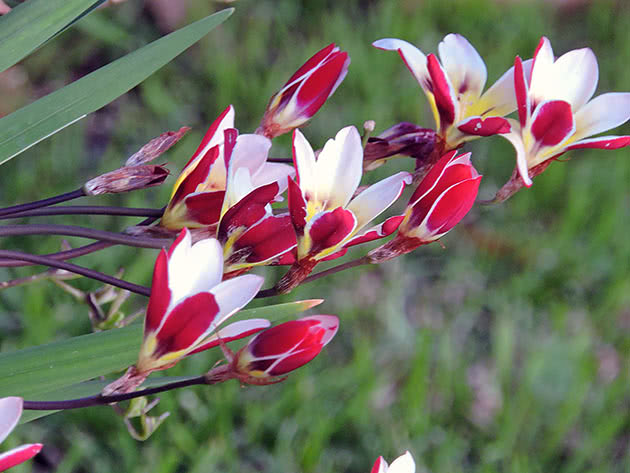

Gardeners are interested in the following varieties:
- Sparaxis Superba - a plant 25-30 cm high with a spike-shaped inflorescence of 5-7 flowers about 5 cm in diameter, white, orange, yellow or purple with a yellow or black center;
- Sparaxis Lord of Fire - flowers in plants of this variety are scarlet with a black center;
- Elegants - a variety of the type of grandiflora with fragrant flowers with dark purple petals, white stamens and a black center;
- sunny day - a plant with creamy lemon flowers with a fuzzy edging at the base of the petals. The middle is pale yellow, also with blurred borders. In the middle of the lower part of the petals there are stripes of a dull purple hue;
- Moon color - an amazingly beautiful plant with lilac-white petals, decorated with scarlet, crimson or dark purple strokes. The middle of the flowers is yellow, the stamens are dark.
Botanical Description of Sparaxis


The genus Sparaxis is a decorative bulbous perennial, of the Iris family, of the order of Asparagus.
The homeland of the flower is the south of Africa. In its natural habitat, the flower grows up to 1 m. In the southern subtropical regions of the European continent, the flower feels confident. Its height rarely exceeds 60 cm when grown outdoors in temperate latitudes, where the number of warm days and the length of daylight hours in summer are significantly lower.
There are dwarf species that are used for landscaping balconies and terraces, like potted crops. Their height is 15 cm.
Sparaxis structure:
- root - corm;
- leaves - lanceolate, erect, rich green, smooth;
- the height of the stem and leaves is from 15 to 60 cm;
- flowers - paired petals located in a stellate bracts, bright, tricolor, up to 5 cm in diameter; the shape is funnel-shaped, inside the flower is a protruding pistil and three slightly curved stigmas.
The bright contrast of petals and long flowering, even in temperate latitudes, in the open field - a powerful argument for its cultivation in garden plots.A bouquet of sparaxis, with long stems and large flowers, can be obtained by March 8, when growing flowers in greenhouses and home heated greenhouses, where it is easier to create the necessary microclimate.
Famous varieties
The genus of the flower is not very similar. Scientists have identified only 6 varieties and up to 20 varieties. In Russia, only those varieties are grown that can develop in such a climate.
We also recommend reading:
Sparaxis Tricolor (tricolor) is a plant with xiphoid stems, the height of which reaches 50 cm. The inflorescence forms purple, red, white or yellow flowers with a bright core of a contrasting shade. A dark colored ring (black or brown) can be seen between the edges and the core. This feature gave the flower its name. On the basis of tricolor sparaxis, scientists have developed several varieties:
- Bilbifer - high inflorescence with yellow or snow-white flowers;
- The lord of fire - bloom with scarlet petals and a black center;
- Low-growing mixture - plants on sturdy stems with yellow, red and white flowers;
- Grandiflora is a tall plant with bright buds against a background of dark green foliage. Flowers can be purple, white, yellow, lilac. They have a strong aroma.
- Striped - bright orange petals contrast in an original way with the yellow center;
- Graceful - a plant up to 15 cm high, decorating the site with orange and yellow flowers.
Sparaxis Superba is a short plant. An adult flower develops up to 35 cm. In a spike-shaped inflorescence, you can count up to 7 buds in the form of stars. When opened, the size of the bud is no more than 5 cm. Against the background of a black or yellow core, purple, orange and white petals contrast effectively.
Description and photo of sparaxis flowers - getting to know the newbie
To begin with, we get acquainted with the newcomer and decide whether to settle him at home or in the garden. Description of sparaxis flowers includes the appearance of the plant, its exactingness to environmental conditions, and cultivation features. The flowering period occurs in the summer months (June - August), the exact timing depends on the time of planting and varietal affiliation. It is possible to distill the bulbs by certain dates in protected ground conditions. Look at the photo of sparaxis flowers - this is a wonderful decoration for a garden and landscaping a living space:
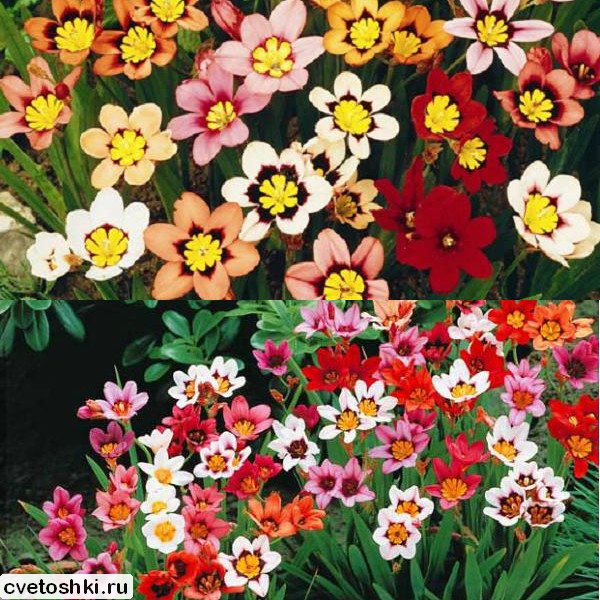

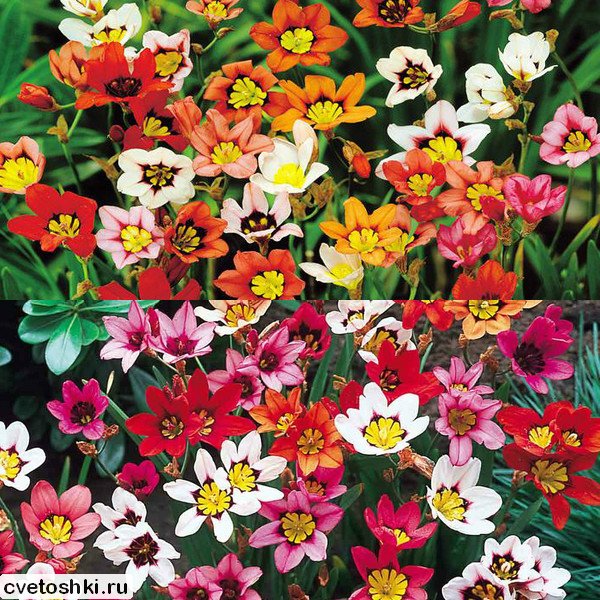

The bud has a funnel-shaped shape; a number of varieties have flowers in the shape of stars. At home, sparaxis produces a flower up to 60 cm high, in open ground the plant reaches a height of 1 meter. At the disposal of florists are also dwarf varieties that give a peduncle up to 15 cm high.The plant belongs to the deciduous group. Perfect for landscaping alpine slides, flower beds and flower beds. Looks beautiful in group plantings of 20 - 30 bulbs, planted at a distance of 15 cm from each other. As a container culture, it will find its place in the landscaping of outdoor terraces, loggias and balconies.
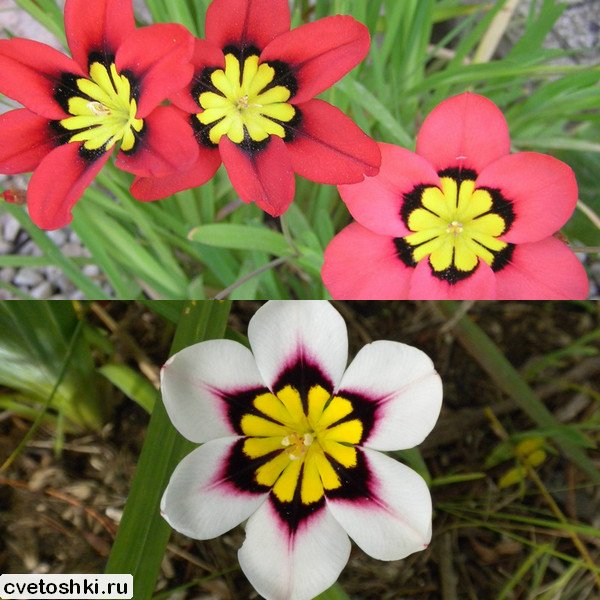

Botanical features of sparaxis:
- thermophilic, in central Russia, special storage of bulbs is required, in the open field they freeze out;
- requires a sufficiently bright place for planting, does not bloom in shade;
- does not tolerate the action of the wind, therefore it is important to protect the plantings with artificial barriers;
- the soil mixture should contain a large amount of organic matter and not retain moisture;
- in the absence of flowering for a long time, it is necessary to add an additional complex mineral fertilizer.
Bulbs can be stored in a cool basement. Sawdust and wood shavings are suitable for this.
Testimonials
Not many growers are involved in the cultivation of Sparaxis. They all leave their comments about this wonderful flower. They confirm the good germination and ease of growing of the plant. Landscape designers say that culture can be used to create a versatile composition.
Unusual acidander gladiolus: growing and care
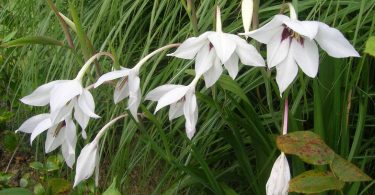

Tigridia: varieties, planting and care in the open field


Features of growing in an open area
It is possible to grow sparaxis in open areas if the bulbs have been stratified and prepared before. In early March, it is necessary to create the desired temperature for the bulbs. It should be slightly lowered. To do this, you need to make holes in the cellophane bag. Then put them in the lower drawers of the refrigerator. The duration of stratification will be 1 month.
Planting crops in open ground takes place in mid-May. In this case, the soil must already be prepared in advance. It must be mixed with organic and mineral fertilizers. For warm regions, where the air temperature does not drop below 15 degrees in winter, planting can take place in the fall.
Further care involves the creation of a shelter for the winter. For these purposes, spruce branches or fallen leaves are used. Before planting in a dug-up place, it is necessary to prepare recesses, the depth of which is 12 cm. They should be located at a distance of 25 cm. It will also be interesting to know when tulips are planted in open ground.
On the video, the features of flower care:
If sparaxis is planted in the spring, then caring for it begins immediately after planting. Water the plant regularly with warm water. As soon as the stems are formed, mineral fertilizers can be introduced. Feeding is worth once a week. To do this, add dissolved mineral complexes to the water. But how the Gladioli are planted in the spring in the ground, and how to do it effectively, is described in great detail in this article.
- Irina, 43 years old: “Last year I decided to plant sparaxis in my flower bed. A very beautiful culture, which was favorably combined with my perennials I have peonies, tulips and gladioli in my flower bed. Taking care of this culture, of course, is problematic. She loves moisture, but at the same time will not tolerate stagnant water. And our summer was too rainy that year. It's good that I thought about the drainage in advance. Otherwise, I would not have been able to save my plants. "
- Ksenia, 26 years old: “I really love growing flowers. What kind of plants I do not have in my flower bed. Every year I try to update it, and 2 years ago a friend gave me sparaxis seeds in the fall. I sowed them in boxes in February. And in the month of May, I planted them in open ground. At the same time, I made sure to take care of the drainage so that excess moisture leaves and does not stagnate. I water the plant during extreme heat every other day. I fertilize once a month using complex fertilizers. "
- Martha, 36 years old: “I saw my sister's sparaxis for the first time. I liked the way they bloom so much that I took the seeds from her the next year. Since I was afraid to plant them immediately in open soil, I first sowed them in separate boxes at the end of February. They sprout amicably and quickly. She kept drawers on a windowsill with good lighting. She planted seedlings in mid-May. Already in June my flower bloomed and continued to bloom until September. "
Read also: Pecan nut: where it grows, how to grow a nut, photo of an ordinary pecan
If you want to create an original and unique flower bed, then you definitely need to pay attention to such a plant as sparaxis. This is an amazing flower that, with proper care, will delight you with bright and abundant flowering until the very frost. Of course, it's not so easy to look after him. But if you approach this matter responsibly, then the plant will reward you generously.
Care
In order to ensure the full flowering of Sparaxis at home, he needs to be provided with appropriate care. When planting a plant, it must be remembered that it blooms fully in sunny places. During the period of active growth, the soil should not be allowed to dry out. That is why regular watering is recommended. The flower must be watered frequently and abundantly.
Attention! The plant loves moist air. That is why it is recommended to spray it regularly.
Fertilize Sparaxis once a month. For this purpose, fertilizers are used for bulbous. In the autumn, top dressing is prohibited.
Growing in a pot
If Sparaxis is grown in a pot, then he needs to provide a slightly different care. In this case, the plant is watered and fed a little more often. For this purpose, it is necessary to introduce mineral fertilizers into the water. It should be used to water the plant. For five liters of water, you need to take 10 grams of fertilizer. The procedure should be performed 2-3 times a month.


Growing sparaxis in a pot
Price
Most often, the bulbs of this plant are sold in a set, which is called assorted, and on such packages you can see the inscription “sparaxis mix". This means that in one pack you will find several different varieties of the same species at once, all of them can be of different colors.
One tuber will empty your wallet in the amount of 10 to 20 rubles. If you decide to take up the cultivation of these representatives of the flora from seeds, you can save a little. You will have to pay about twenty to thirty rubles for the package.
But an exhibit already grown by someone else's hands is a more expensive pleasure. Much depends on the variety. Based on which one you have chosen, one inflorescence is estimated at an amount from 200 to 400 tons. Plus you will have to spend money on a suitable pot.
Plant characteristic
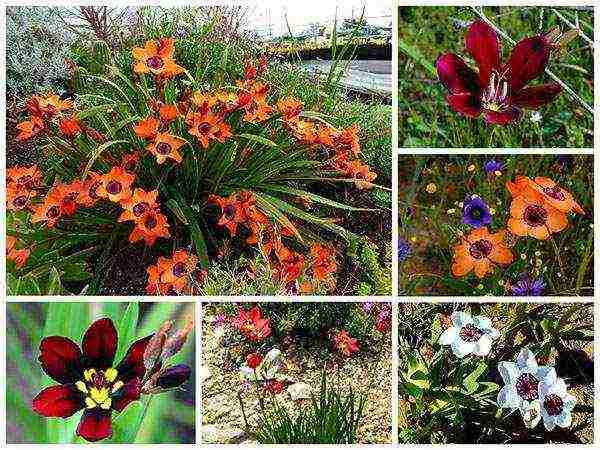

Sparaxis is considered a deciduous species. The plant has a tuberculous root system, long fleshy leaves, reaching a height of 90-100 cm with a spikelet. The foliage is dark green in color, with a sinewy structure. The flowering period is from May to June. Sparaxis flowers are distinguished by a bright color with a contrasting core and a pistil in the middle, a flower diameter of about 5 cm. At the end of August or in the first decade of September, the plant dries up and sheds its foliage, leaving only underground tubers. Gardeners have 20 varieties. In temperate climates, in order to plant and care in the open field of sparaxis, varieties are selected that are most adapted to the given weather conditions.
Planting a flower
At the end of flowering in the fall, the bulbs grow well, and they are divided into several pieces. To do this, they are carefully dug out without damaging the roots. The bulbs are stored until spring in rooms where the temperature does not drop below +90. In order to preserve their viability, the bulbs are covered with sawdust. So the plant will remain viable for up to 3 years.
Before planting in open ground, boxes with corms are transferred to a warm room with a temperature of +250. Planting is carried out directly in open ground or in pots. To do this, first prepare a light substrate with drainage. Most preferred for planting loam with organic fertilizers and sand. A place protected from the winds with good lighting is selected in the garden.
In temperate climates, planting in open ground is carried out no earlier than March. In the southern regions, planting is allowed in the fall. In this case, the bulb is buried in open ground by 10 cm, maintaining a distance of 15 cm. The autumn planting begins to bloom in May and keeps flowers until mid-summer. When planted in spring, flowering occurs in mid-July.
Impressive beauty of sparaxis inflorescences
Sparaxis are far from the largest of the representatives of bulbous plants. In height, the peduncles of this exotic reach only 60 cm, while the bulb does not release so many leaves and does not create beautiful rosettes. In order for sparaxis to form a beautiful "spot" or group, the bulbs must be placed very tightly, planted almost next to each other.
Sparaxis is a genus of the Iridaceae family, which includes 15 species of perennial herbaceous corms.
Sparaxis cannot boast of a wide variety of species.This is a plant with several forms of growth, which today are divided into 4-5 wild natural species. In landscape design, only two of them are used - tricolor sparaxis (Sparaxis tricolor) and graceful dwarf sparaxis (Sparaxis elegans). Smooth, lanceolate leaves without a fringe only visually emphasize a rather powerful peduncle. But any shortcomings of greenery, including paucity, are more than compensated for by the beauty of flowering. In sparaxis it is not just decorative, but colorful and extravagant. Flowering begins in regions with mild winters in late spring and early summer, but in the middle lane and to the north - much closer to autumn, in colorful August or September. The flowers are stellate, up to 5 cm in diameter. A dark ring separates the bright yellow center with stamens from the main color of the petals, which creates an almost graphic effect. In different sparaxis, single-color orange, yellow, pink, white, cream colors are replaced by various variegated combinations that seem to be hand-painted patterns on the petals. In dwarf sparaxis, the colors are more limited: the flowers flaunt either white or orange.
In the design of the garden, sparaxis use:
- to create colorful spots on the lawn and meadows from ground cover;
- as luxurious accents in the foreground of flower beds and mixborders;
- in large groups and in mono flowers;
- in flower beds of bulbous and corms requiring digging;
- for decorating rockeries, front gardens;
- as a cut culture;
- for decorating rooms, greenhouses, winter gardens.
Favorite varieties
If you haven’t dealt with this plant yet, first choose the variety you like that will delight you the most with sparaxis. Planting and caring for all varieties is the same, so the choice depends solely on your taste. Most often found in gardens:
- The lord of fire. Almost the most spectacular variety: fiery scarlet ligature on a velvety black background really evokes the feeling of a fiery dance.
- Tricolor sparaxis. Most often grown in the south of Russia. A fairly short flower, but with a strong and sturdy stem. Each cup combines three colors: two shades of one and a contrasting center. Usually the variety is sold commercially as a mix.
- Bilbeefer. The variety is attractive for its love of sandstone, on which most plants most often wither. Quite tall flowers with a very delicate color - white or in combination with different tones of yellow.
- Grandiflora. Highest and most fragrant. The aroma is very strong and bright, but not sugary.
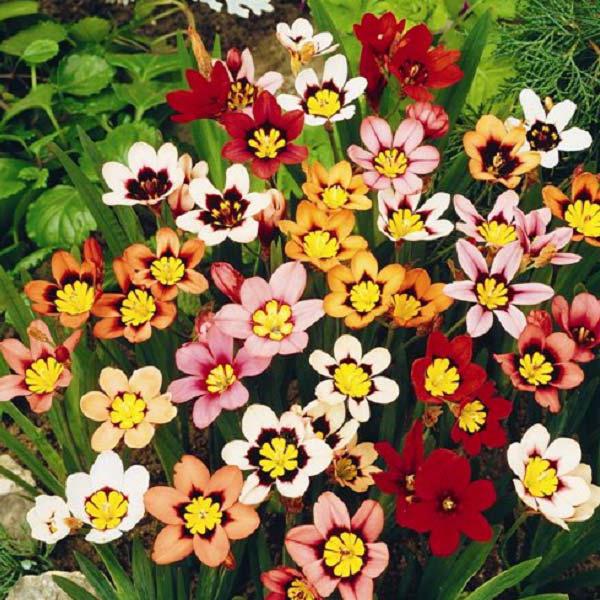

Planting rules and care requirements
Iberis planting, outdoor care
For breeding sparaxis, places open to sunlight are preferable. In this case, you should make sure that there are no other plants nearby that can form a shadow. The soil is preferable loamy, enriched with humus. Tubers of low varieties are planted at intervals of four to five centimeters, and for taller ones, this figure should be doubled. At the initial stage of flower growth, it is necessary to monitor a sufficient rate of water. Otherwise.
Sparaxis leaves may begin to turn yellow, and the number of inflorescences will decrease significantly. To avoid this, watering should be carried out regularly and additionally, twice a day, spray the foliage using exceptionally warm water. This is done in the morning and evening and helps protect foliage from sunburn.
Don't forget to drain the sparaxis. It is considered moisture-loving, but with stagnant water it is quite capable of starting to rot.
Plant feeding and pruning
With the appearance of small leaves, it is necessary to begin to support the sparaxis with mineral-containing components. It is best to add them when watering, adding ten grams of the drug to a bucket of water. Dried or damaged parts of the plant are pruned.This is done to preserve the attractive appearance of sparaxis.
Reproduction methods
There are several of them. Planting tubers in open ground is considered the most effective and convenient. At the end of flowering, in the second half of summer, you must wait until the leaves are completely dry and dig up the bulbs. This is done because Sparakisis does not tolerate our winter conditions and is capable of perishing. The planting material is insulated with sawdust, straw or peat and stored until spring at a temperature of at least nine degrees Celsius. Shortly before planting, the tubers should be warmed up, creating them temperature conditions of about twenty-five heat.
You can grow a flower in pots. To do this, in the fall, no more than four tubers are planted in a container, they are watered. You can put the pots on the windowsill, eliminating the possibility of drafts. Flowering begins in about three months.
If you decide to use seeds, the conditions should be greenhouse, close to indoor conditions. Sowing is carried out in boxes with a height of at least 10 cm. Seedlings are thinned out, leaving a distance of about two centimeters between them. In open places, you can transplant at a time when the seedlings reach at least five centimeters in height.
By growing sparaxis, you get a great opportunity to decorate your site with amazing flowers. And in cut form, combined with other plants, the representative of South Africa looks just amazing. It looks great as a design element on balconies and loggias.
Landing features
Planting crops in spring should be carried out according to strictly established rules, which will provide them with abundant flowering. In early spring, it is necessary to move the bulbs indoors and provide them with a temperature of 25 degrees. Most flower growers have a question: when to plant Sparaxis? After the night frosts are over, the bulbs can be planted in the ground.
Important! When choosing a location, it is necessary to give preference to well-lit options that are protected from the wind.
When planting a plant, it is necessary to ensure that the depth of the holes does not exceed 5 centimeters. The distance between flowers should be between 4 and 10 centimeters, depending on the type of flowers. Cultivation of the crop should be carried out in loamy soils, which are pre-drained and well fertilized. With excessive moisture in the soil, rotting of the bulbs can be observed.
Care during and after flowering
Mandatory procedures and agrotechnical measures:
- careful removal of faded buds from the stems;
- top dressing with the use of mineral fertilizers, in which the percentage of potassium and phosphorus content is increased;
- loosening the soil to improve air exchange, reduce the risk of dense crust formation;
- weed control. Weeding is carried out as needed. It is important to remove weeds entirely, with roots, while Sparaxis is still young, so that harmful plants do not clog the growth of a beautifully flowering species;
- mulching is optional. Peat, chopped straw or sawdust are poured near the root zone if it is dry season, and the moisture evaporates quickly, despite regular watering. Mulching is performed after wetting the substrate.
Popular varieties
The genus of sparaxis is not very diverse, scientists distinguish only 6 varieties and about 20 plant varieties. In our country, only some of them are cultivated, which is due to the exactingness of the climate.
Tricolor sparaxis, also known as tricolor. Stems and xiphoid leaves reach a height of 40-50 cm. Red, purple, yellow or white flowers are formed in the inflorescence. Their core is bright, different in tone from the main color of the petals. A dark brown or black ring is visible between the core and the edges of the petals. For this feature, the species got its name, because on each flower there are three different colors at once. The transitions between them are clear, not smoothed.Based on this species, the following varieties have been bred:
- the lord of fire - scarlet petals with a black center;
- grandiflora - a tall variety with dark green foliage and bright inflorescences of white, purple, lilac, yellow, has a strong aroma;
- undersized mixture - red, yellow and white flowers flaunt on strong stems up to 15 cm high;
- bilbeifera - tall inflorescences are decorated with snow-white or yellow flowers;
- striped - bright orange petals seem to shimmer with tongues of flame and contrast with the yellow middle;
- graceful - a miniature plant, 10-15 cm high, decorated with yellow and orange flowers.
Sparaxis tricolor
Sparaxis Superba is not tall. An adult flower reaches 25-35 cm. In a spike-shaped inflorescence, there are 5-7 star-shaped buds. The size of the open bud does not exceed 5 cm. The white, orange, purple and yellow petals contrast with the yellow or black core.
Sparaxis superba
Application in landscape design
In order to arrange an original landscape design, it is necessary to carry out a mass planting of a plant. For this purpose it is recommended to use a variety of Sparaxis varieties. The ideal combination of this flower is succulents and conifers.
Disembarkation of sparaxis at the site.
Since the bush does not reach a great height, it must be planted in the foreground of the flower bed. If the site is small, then planting of the plant is recommended to be carried out in pots. Photo of Sparaxis will help determine the features of his landing site.


Sparaxis wintering
Dried sparaxis corms are not usually stored. They are much more sensitive than other bulbous plants, and they need to provide more than just coolness to survive the long winter and early spring. Sparaxis bulbs are stored in dry sawdust and only in complete darkness. The optimum air temperature is from 5 to 7 degrees Celsius. Rotting and drying out are equally dangerous for bulbs, therefore, air humidity should be given increased attention, avoiding extreme indicators.
Comfortable conditions for the plant
Sparaxis is a capricious plant that requires careful care
The gardener's task is not only to achieve flowering of sparaxis, but to get large and bright flowers. This can be achieved only if comfortable conditions are created for the plant:
- Maximum protection against drafts.
- Access to sunlight from morning to evening... Even light shading during the day is not acceptable.
- Ideal soil composition... A simple cultivated layer of soil is not suitable for sparaxis and it will not be able to grow in such soil.
- Balanced hydration. Sparaxis bulbs are extremely sensitive to waterlogging and lack of moisture. If there is no drainage in the hole, the plant will not be properly watered. The soil layer must be completely moistened, and this can only be achieved by abundant watering with the removal of excess moisture through the drainage.
Full price list of services
VISAGISTE
| Makeup artist services | rub. |
| make-up | 2500 |
| hairstyle | from 1500 |
| long-term styling of eyebrows | from 1500 |
| facial waxing Lycon zonal | from 350 to 2000 |
| eyebrow correction with henna staining | 1000 |
FACE CARE
| Facial cleansing (duration 2 hours) | rub. |
| mechanical cleaning with care along the Holy Land line (Israel) | 1800 |
| Holy Land (Israel) treatment for problem skin | 1400 |
| Ultrasonic / combined | 1800 |
| Peelings (duration 1 hour) | rub. |
| Peeling almond NATINUEL (Italy) | 1500 |
| Peelings on the NATINUEL problem (Italy) | 1500-2500 |
| Peelings SESDERMA (Spain) | from 1500 |
| Express care | rub. |
| ACADEMIE care with ampoules (France) | 2000-2200 |
| Express treatments COMFORT ZONE (Italy) for skin problems | 2500-3000 |
| Care for the skin around the eyes from NATINUEL | 1200 |
| microcurrent lifting (lymphatic drainage, increased collagen and elastin content, excellent aesthetic results) | 1200 |
| Eyebrow correction | rub. |
| eyebrow shaping | 600 |
| eyebrow tinting and shaping | 700 |
| Henna staining + correction | 800 |
| Facial massage | rub. |
| modeling | 1000 |
| Japanese KOBIDO | 1500 |
BODY CARE
| Pressotherapy (duration 30 min) | rub. |
| Pressotherapy | 600 |
| Depilation | rub. |
| hands | 600 |
| legs | 700-1000 |
| bikini | 1500 |
| armpits | 500 |
| face area | from 250 |
THE HAIRDRESSER
| Hair styling (wash / mask) | rub. |
| Hair Styling | from 1000 |
| hairstyle for a celebration | from 1500 |
| Hair coloring ILLUMINA, KOLESTON (styling included) | rub. |
| Wella staining | from 3000 |
| A haircut | rub. |
| female | 1200 |
| male | 800 |
| preschool | 400 |
| children's school | 600 |
| Highlighting | rub. |
| Blondor cream / powder | from 2800 |
| DAVINES (Italy) - hair care products of your choice | rub. |
| Keratin | from 1500 |
| Sealing | from 1500 |
| Scalp peeling | from 1500 |
MANICURE
| Manicure | rub. |
| classic / hygienic | 800 |
| hardware | 800 |
| Japanese manicure MASURA | 1000 |
| Nail coating | rub. |
| 3-phase nail coating without manicure | 300 |
| covering the natural nail with gel polish | 700 |
| gel extension CNI | 2000 |
| gel correction CNI | 1300 |
| strengthening nails with manicure | 1600 |
| design "French" | 200 |
PEDICURE
| Pedicure | rub. |
| Enzymatic pedicure Golden Trace | 1700 |
| female classic / hygienic | 1100 |
| male classic / hygienic | 1300 |
| Hardware pedicure GEHWOL | 1300-2000 |
| peeling pedicure ADN | 1400 |
| Japanese pedicure MASURA | 1300 |
MASSAGE
| Massage types | rub. |
| baby massage (for children from 6 to 12 years old) | 800 |
| lymphatic drainage massage | 1500 |
| Anticellulite massage | 1300 |
| Body Strategist mask massage (rejuvenation and firmness) | 2300 |
| back massage | 1000 |
| general wellness massage (achieving physical and psychological comfort) | 1800 |
| Bagni de Pisa mask massage (detoxification) | 2300 |
| honey massage (intense effect! Cleansing, nutrition, removal of toxins, increased skin turgor, tissue regeneration, acceleration of metabolic processes, in the fight against cellulite.) | 1800 |
| teenage massage (from 12 to 16 years old) | 1100 |
| Stone therapy | 2500 |
SPA PROGRAMS
| Spa programs (duration 1 hour) | rub. |
| Spa-program cosmetics Comfort zone (Italy) | 3000 |
| Body Strategist mask massage "Rejuvenation and Firmness" | 3000 |
| Spa-program "Bavarian chocolate" (scrubbing / mask-wrap / final care tightening cream) | 2000 |
| AROMASOUL cosmetics Comfort zone (Italy) (volcanic scrubbing) | 2000 |
| BAGNI de Pisa detox SPA massage | 2000 |
Brief description and main types of plants, photo
The flower is considered a perennial, bulbous, there are 6 species and a lot of varieties. It begins to bloom in late spring or early summer, loves warmth very much. Does not tolerate frost, bulbs are dug up for the winter period. The most famous types include the following:
Lord of fire
- a very beautiful variety, like flames on a black background.
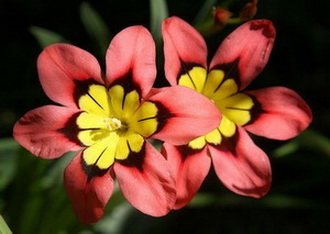

- has numerous varieties, flowering in yellow and white, pink. Blooms in early summer.
Grandiflora
- elongated flowers, different colors yellow, white purple, very aromatic variety - fragrant.
Elegants
- blooms in white, orange - apricot color, with a purple, almost black center.
Striped
- has a yellow core and orange petals.
Distilling sparaxis at home
There are two ways to grow sparaxis at home. The first is constant growth in a special pot. The difficulty lies in the fact that the culture requires a period of winter dormancy. It is very difficult to provide it in a city apartment. Forcing sparaxis from backyard bulbs is the best way to get great flowers in winter. Sparaxis is often grown on specific dates. For example, in order to be able to donate a flowering plant on March 8, it is necessary to start forcing the sparaxis bulb around November. During this period, the bulbs are placed in the refrigerator for stratification for 30 days. In mid-December, the bulbs are planted in deep pots in groups. For 1 pot with a capacity of 8 liters, you can plant 3 bulbs. With a pot volume over 10 liters, a group of 5 bulbs can be planted. After the sprouts appear, additional illumination is required using a phytolamp. It needs to be illuminated daily for 5-6 hours. Regular watering and weekly application of mineral fertilizers guarantee rapid plant development and abundant flowering just in time.
Reproduction
There are two ways to propagate a plant: by bulbs and seeds. Let's consider each of them.
Bulbs
In autumn, when the flowering period ends, the bulbs grow well and can be divided. You need to carefully dig them out so as not to damage the roots. They should be stored indoors, with an air temperature of at least +9 ° C.Bulbs also propagate such garden flowers as colchicum, snowdrop, gladiolus, lily, hazel grouse, daffodil, tulip, lycoris, ixia, kandyk, allium, zephyranthes, chionodox and dahlia. In order to preserve the viability of the bulbs, it is recommended to overlay them with sawdust - this will extend their germination ability up to 3 years. The tubers are planted at the beginning of autumn; for this, pots of 2-3 liters are prepared. Loams are chosen as the soil, to which organic matter and sand are added. Do not place more than 4 bulbs in one pot. You can place containers on the windowsill, performing abundant watering. There should be no drafts in the room. Important! To speed up the onset of the flowering period, you need to illuminate the plant with a special lamp for 6 hours every day. If this is not done, flowering can be delayed for several months.
Seeds
For sowing seeds, it is worth choosing a warm room (sowing in an open bend is undesirable) and wide containers 8-10 cm high. They are sown according to the 2x2 cm scheme, and after the sprouts grow to 8 cm, they are planted in pots and left in a lighted place. In order for the plant to bloom, in winter the temperature in the room should be at the level of + 15 ... + 20 C. When planting, keep in mind that it will bloom only in the second year.
About culture
Sparaxis is a member of the iris family. It is a deciduous plant and is characterized by the presence of a bulbous root system. The flower stems reach a height of one meter. When grown in temperate climates, Sparaxis is between 15 and 20 centimeters tall. The flower is characterized by the presence of lanceolate leaves, which are characterized by a dark green color and sinewy.


Sparaxis bloom in the garden.
Bright flowers appear on the plant in late May or early June. They are characterized by the presence of a contrasting core, which can have a red, white, violet, yellow, lilac color. Flower petals are characterized by different shades. The flower can be funnel-shaped or fully open.



